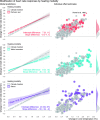Meta-analysis of heat-induced changes in cardiac function from over 400 laboratory-based heat exposure studies
- PMID: 40087302
- PMCID: PMC11909281
- DOI: 10.1038/s41467-025-57868-6
Meta-analysis of heat-induced changes in cardiac function from over 400 laboratory-based heat exposure studies
Abstract
Heat waves are associated with increased fatalities from adverse cardiovascular events attributed to the negative effects of heat on cardiac function. However, scientific understanding of acute cardiac adjustments to heat has come primarily from laboratory experiments employing insulated and encapsulated heating modalities, most commonly water-perfused suits. We evaluated whether findings from those studies reflect cardiac responses during more natural exposures to hot ambient conditions simulated in climate-controlled chambers by synthesizing the findings from over 400 laboratory-based heat exposure studies (6858 participant-exposures) published between 1961-2024. Among all included studies, median (interquartile range) elevations in core temperature and heart rate from baseline to end-exposure were 0.9 (0.5-1.3)°C and 27 (15-40) beats/min. Multilevel mixed-effects meta-analyses revealed exacerbated elevations in heart rate, cardiac output, and rate pressure product (estimate of cardiac workload) and blunted falls in systolic pressure in participants heated via encapsulated modalities. Leveraging the large dataset, we also provide empirical estimates of body temperature and cardiovascular responses to a wide range of conditions experienced during heat waves. With rising global temperatures, ecologically-minded physiological research is needed to improve understanding of the effects of heat stress on cardiac responses and further the development of robust climate health models and evidence-based heat-health guidance.
© 2025. The Author(s).
Conflict of interest statement
Competing interests: The authors declare no competing interests.
Figures






References
-
- Khraishah, H. et al. Climate change and cardiovascular disease: implications for global health. Nat. Rev. Cardiol.19, 798–812 (2022). - PubMed
-
- Chaseling, G. K., Morris, N. B. & Ravanelli, N. Extreme heat and adverse cardiovascular outcomes in Australia and New Zealand: What do we know? Heart Lung Circ.32, 43–51 (2022). - PubMed
Publication types
MeSH terms
Grants and funding
- R01 AG069005/AG/NIA NIH HHS/United States
- 399434/Gouvernement du Canada | Canadian Institutes of Health Research (Instituts de Recherche en Santé du Canada)
- RGPIN-2020-03891/Gouvernement du Canada | Natural Sciences and Engineering Research Council of Canada (Conseil de Recherches en Sciences Naturelles et en Génie du Canada)
LinkOut - more resources
Full Text Sources

